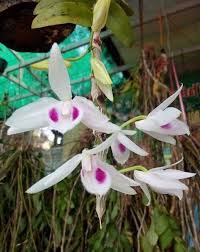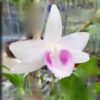# Phalaenopsis Orchids and Their Significance in Calligraphy Art

## Introduction
Phalaenopsis orchids, commonly known as moth orchids, have long captivated the hearts and minds of people across cultures. Renowned for their elegance and striking beauty, these flowers have found their way into various artistic expressions, particularly in calligraphy. Calligraphy, the art of beautiful writing, has deep roots in several cultures, particularly in East Asia, where the aesthetics of writing intertwine with the symbolism of nature. This article explores the significance of Phalaenopsis orchids in the realm of calligraphy, examining their cultural meanings, representation in artistic works, and their enduring influence on artists and calligraphers.
## 1. Understanding Phalaenopsis Orchids
### 1.1 Botanical Characteristics
Phalaenopsis orchids belong to the family Orchidaceae, one of the largest and most diverse families of flowering plants. They are characterized by their broad, flat leaves and long-lasting, vibrant blooms that can range in color from white and pink to deep purple and yellow. These orchids typically bloom once or twice a year, with flowers that can last for several months.
### 1.2 Natural Habitat
Native to tropical regions of Southeast Asia, Phalaenopsis orchids are epiphytes, meaning they grow on other plants without harming them. In their natural habitat, they thrive in humid, warm environments with filtered light. This adaptability allows them to flourish in various conditions, making them popular choices for home gardening.
## 2. The Cultural Significance of Phalaenopsis Orchids
### 2.1 Symbolism in Eastern Culture
In many Eastern cultures, flowers symbolize various virtues and concepts. Phalaenopsis orchids, in particular, are associated with beauty, refinement, and elegance. In Chinese culture, orchids represent fertility and abundance. Their delicate petals and graceful form evoke feelings of gracefulness, making them popular subjects in art and poetry.
### 2.2 The Orchid as a Symbol of Love and Friendship
Orchids, including Phalaenopsis, have long been regarded as symbols of love, friendship, and beauty. Their stunning appearance makes them ideal gifts for loved ones. The gesture of giving orchids often conveys admiration, respect, and appreciation. In calligraphy, this symbolism is often reflected through the choice of characters and phrases that celebrate relationships and connections.
## 3. Phalaenopsis Orchids in Calligraphy
### 3.1 Historical Context
The practice of calligraphy has a rich history that dates back thousands of years, especially in Chinese and Japanese cultures. Calligraphy is not merely about writing; it embodies artistic expression, philosophical depth, and cultural identity. The inclusion of natural elements, such as flowers, in calligraphy has been a longstanding tradition, as these elements enhance the beauty and meaning of the written word.
### 3.2 Artistic Representation of Orchids
In calligraphy, Phalaenopsis orchids are often depicted alongside elegant brushstrokes that convey fluidity and grace. Artists may incorporate images of orchids into their works to symbolize themes such as beauty, purity, and spiritual enlightenment. The visual representation of orchids complements the text, creating a harmonious balance between imagery and words.
### 3.3 Calligraphic Techniques and Styles
Different calligraphic styles can influence how orchids are represented in art. For instance, traditional Chinese calligraphy employs brush techniques that allow for dynamic strokes, capturing the essence of the orchid’s delicate features. The choice of ink and paper also plays a crucial role in how the final artwork is perceived.
## 4. Symbolism of Phalaenopsis Orchids in Calligraphic Works
### 4.1 Themes of Beauty and Grace
In calligraphic art, Phalaenopsis orchids often symbolize beauty and grace. The intricate designs of the flowers are mirrored in the flowing lines of the calligraphy, creating a visual representation of these qualities. Phrases that celebrate beauty, love, and elegance are commonly paired with images of orchids, reinforcing their significance.
### 4.2 Spiritual and Philosophical Meanings
In many cultures, orchids are seen as a representation of spiritual growth and enlightenment. In calligraphy, this connection is expressed through the use of philosophical quotes or poetry that speaks to the human experience. The juxtaposition of words and images allows the viewer to contemplate the deeper meanings behind both the orchids and the text.
### 4.3 Celebrating Nature’s Beauty
Calligraphy that features Phalaenopsis orchids often serves as a tribute to the beauty of nature. Artists express their admiration for the natural world through their choice of subjects, highlighting the delicate balance between human creativity and the beauty found in flora.
## 5. The Process of Creating Calligraphy with Phalaenopsis Orchids
### 5.1 Materials Needed
To create calligraphic art featuring Phalaenopsis orchids, artists typically require the following materials:
– **Brushes**: Traditional calligraphy brushes, which come in various shapes and sizes, allow for versatile stroke techniques.
– **Ink**: Black or colored ink is used to create the calligraphy. Water-based ink is commonly preferred for its smooth application.
– **Paper**: High-quality rice paper or calligraphy paper is ideal for achieving the desired texture and absorbency.
– **Reference Images**: Photographs or sketches of Phalaenopsis orchids serve as references for accurately capturing their form.
### 5.2 Sketching the Design
Before applying ink, artists often sketch a rough outline of the orchids and accompanying calligraphy. This step allows for adjustments and ensures that the composition is balanced.
### 5.3 Calligraphy Techniques
Artists may employ different calligraphy techniques to enhance their artwork. Some popular techniques include:
– **Thick and Thin Strokes**: Varying the pressure on the brush creates a dynamic contrast in stroke thickness, adding depth to the characters.
– **Flourishing**: Adding decorative flourishes around the letters can enhance the overall composition, echoing the curves of the orchid petals.
### 5.4 Finalizing the Artwork
Once the calligraphy is complete, artists can add color to the orchids using watercolor or ink washes. This final touch enhances the visual appeal and brings the artwork to life.
## 6. Phalaenopsis Orchids in Contemporary Calligraphy
### 6.1 Modern Interpretations
In contemporary calligraphy, artists are experimenting with new styles and techniques. The incorporation of Phalaenopsis orchids in modern works reflects evolving artistic expressions and the integration of traditional and contemporary elements.
### 6.2 Calligraphy Workshops and Exhibitions
Many calligraphers and artists participate in workshops and exhibitions to showcase their work. These events often highlight the role of nature, including orchids, in calligraphic art, allowing artists to share their passion and skills with others.
### 6.3 The Influence of Social Media
Social media platforms have transformed how artists share their work. Many calligraphers now use Instagram, Pinterest, and other platforms to showcase their orchid-themed calligraphy, reaching a broader audience and inspiring others to explore the art form.
## 7. The Therapeutic Aspect of Calligraphy
### 7.1 Mindfulness and Creativity
Engaging in calligraphy can be a meditative practice that promotes mindfulness. The focused attention required to create intricate letters and designs can lead to relaxation and a sense of peace. Incorporating nature, such as Phalaenopsis orchids, into the practice enhances the therapeutic benefits by connecting the artist to the beauty of the natural world.
### 7.2 Emotional Expression
Calligraphy allows artists to express their emotions and thoughts through both words and imagery. The inclusion of orchids can symbolize personal meanings and experiences, creating a deeper connection between the artist and their work.
## 8. Prominent Calligraphers and Their Works Featuring Orchids
### 8.1 Historical Figures
Throughout history, several prominent calligraphers have incorporated flowers, including orchids, into their works. Figures such as Wang Xizhi, known as the Sage of Calligraphy, have inspired generations of artists to explore the relationship between text and nature.
### 8.2 Contemporary Artists
Modern calligraphers, such as Koji Takeda and Julie J. R. Duran, are making waves in the art community with their unique interpretations of natural elements, including Phalaenopsis orchids. Their works often blend traditional techniques with innovative styles, creating visually stunning pieces that resonate with audiences.
## 9. The Global Appeal of Phalaenopsis Orchids in Calligraphy
### 9.1 Cultural Exchanges
As the appreciation for Phalaenopsis orchids and calligraphy grows worldwide, cultural exchanges are becoming more common. Artists from various backgrounds are incorporating orchids into their calligraphic practices, showcasing the universal appeal of these beautiful flowers.
### 9.2 Collaborative Art Projects
Collaborative art projects that involve calligraphy and floral arrangements are gaining popularity. Artists from different disciplines come together to create works that celebrate the beauty of orchids and the art of writing, fostering a sense of community and shared creativity.
## 10. Conclusion
Phalaenopsis orchids hold a special place in the world of calligraphy, serving as symbols of beauty, grace, and spiritual growth. Their intricate designs and rich cultural significance provide inspiration for artists and calligraphers alike. By exploring the connection between these exquisite flowers and the art of writing, we can appreciate the depth and complexity of both forms of expression. As we continue to celebrate the beauty of Phalaenopsis orchids in calligraphy, we honor the traditions of the past while paving the way for new artistic interpretations in the future. Through this artistic journey, we not only deepen our understanding of orchids but also foster a greater appreciation for the delicate interplay between nature and art.

